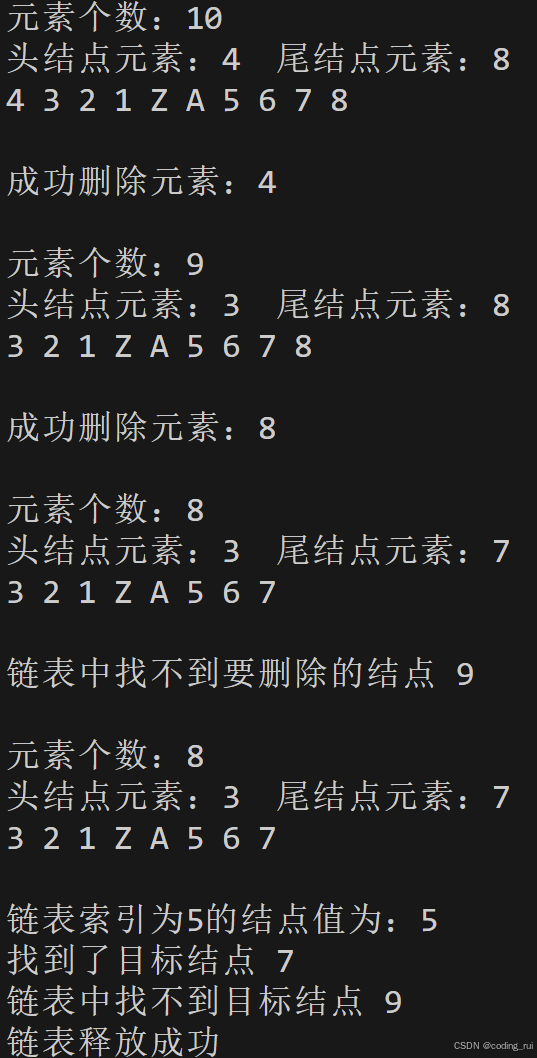文章目录
链表
链表:是用"链"将结点串联起来的数据结构。
结点:是一个对象(在C语言中就是一个结构体)。该对象中有数据域和指针域,数据域顾名思义存放的就是数据,指针域存放的是结点(可以是另一个结点,也可以是自身)的地址。

链表的分类:

循环链表我们用的一般比较少,但是当处理的数据具有环形结构时,就特别适合用循环链表,比如约瑟夫环问题。接下来我们讨论下最常用单向链表和双向链表。
1.1 单链表
基本操作
-
添加 (在某个结点后面添加) O(1)
-
删除 (在某个结点后面删除) O(1)
-
查找
a. 根据索引查找结点 O(n)
b. 查找链表中与特定值相等的结点(大小有序O(n) 大小无序O(n))
实现
代码
c
// main.c
#include <stdio.h>
#include "list.h"
int main(void) {
List* list = create_list();
add_node(list, 0, 'A');
add_before_head(list, '1');
add_before_head(list, '2');
add_before_head(list, '3');
add_before_head(list, '4');
add_behind_tail(list, '5');
add_behind_tail(list, '6');
add_behind_tail(list, '7');
add_behind_tail(list, '8');
add_node(list, 4, 'Z');
traverse_list(list);
delete_node(list, '4');
traverse_list(list);
delete_node(list, '8');
traverse_list(list);
delete_node(list, '9');
traverse_list(list);
Node* findNode = find_by_index(list, 5);
if (findNode != NULL)
printf("链表索引为5的结点值为:%c\n", findNode->val);
search_for_value(list, '7');
search_for_value(list, '9');
destroy_list(list);
return 0;
}
c
// List.h
// 定义结点类型
typedef struct node {
char val;
struct node* next;
} Node;
// 存放整条链表的信息
typedef struct {
Node* head;
Node* tail;
int size;
} List;
// API
List* create_list();
void destroy_list(List* list);
void add_before_head(List* list, char val);
void add_behind_tail(List* list, char val);
void add_node(List* list, int idx, char val);
void delete_node(List* list, char val);
void traverse_list(List* list);
Node* find_by_index(List* list, int idx);
Node* search_for_value(List* list, char val);
c
// List.c
#include <stdio.h>
#include "list.h"
#include <malloc.h>
// 创建链表
List* create_list() {
List* list = (List*)malloc(sizeof(List));
list->head = NULL;
list->tail = NULL;
list->size = 0;
// 创建list结构体之后,list->head和list->tail都是NULL,
// 直接访问list->head->next和list->tail->next会导致解引用未初始化的指针,引发未定义行为(通常是程序崩溃)。
// list->head->next = NULL; /* WRONG */
// list->tail->next = NULL; /* WRONG */
return list;
}
// 释放链表
void destroy_list(List* list) {
// 1. 释放所有结点
Node* cur = list->head;
while (cur != NULL) {
Node* next = cur->next;
free(cur);
cur = next;
}
// 2. 释放List结构体
free(list);
printf("链表释放成功\n");
}
// 头插法
void add_before_head(List* list, char val) {
Node* newNode = (Node*)malloc(sizeof(Node));
newNode->val = val;
newNode->next = list->head;
list->head = newNode;
if (list->tail == NULL) // 最初插入的结点作为尾节点
list->tail = newNode;
list->size++;
}
// 尾插法
void add_behind_tail(List* list, char val) {
Node* newNode = (Node*)malloc(sizeof(Node));
newNode->val = val;
newNode->next = NULL;
if (list->head == NULL) // 最先插入的结点为头结点
list->head = newNode;
if (list->tail != NULL)
list->tail->next = newNode;
list->tail = newNode;
list->size++;
}
// 索引插入
void add_node(List* list, int idx, char val) {
if (idx < 0 || idx > list->size) {
printf("链表索引输入错误\n");
return;
}
if (idx == 0) { // 头插
add_before_head(list, val);
return;
}
if (idx == list->size) { // 尾插
add_behind_tail(list, val);
return;
}
// 在链表中间插入的情况
Node* cur = list->head;
for (int i = 0; i < idx - 1; i++) {
cur = cur->next;
} // i = idx - 1
Node* newNode = (Node*)malloc(sizeof(Node));
newNode->val = val;
newNode->next = NULL;
newNode->next = cur->next;
cur->next = newNode;
list->size++;
}
// 删除链表结点
void delete_node(List* list, char val) {
if (list->head == NULL) {
printf("空链表,无法删除结点\n");
return;
}
Node* prev = NULL;
Node* cur = list->head;
while (cur != NULL) {
if (cur->val == val) { // 找到了要删除的元素
// 注意头结点和尾结点是否改变
if (cur == list->head) // 如果要删除的是头结点
list->head = cur->next;
if (cur == list->tail) // 如果要删除的是尾结点
list->tail = prev;
Node* pTmp = cur;
if (prev != NULL)
prev->next = cur->next;
free(pTmp);
pTmp = NULL;
list->size--;
printf("成功删除元素:%c\n\n", val);
return;
}
prev = cur;
cur = cur->next;
}
// 链表里没有要删除的结点
printf("链表中找不到要删除的结点 %c\n\n", val);
}
// 遍历链表
void traverse_list(List* list) {
Node* cur = list->head;
printf("元素个数:%d\n", list->size);
printf("头结点元素:%c 尾结点元素:%c\n", list->head->val, list->tail->val);
while (cur != NULL) {
printf("%c ", cur->val);
cur = cur->next;
}
printf("\n\n");
}
// 按索引查找
Node* find_by_index(List* list, int idx) {
if (idx < 0 || idx > (list->size - 1)) {
printf("链表索引输入错误\n");
return NULL;
}
Node* cur = list->head;
for (int i = 0; i < idx; i++) {
cur = cur->next;
}
return cur;
}
// 按值查找
Node* search_for_value(List* list, char val) {
Node* cur = list->head;
while (cur != NULL) {
if (cur->val == val) {
printf("找到了目标结点 %c\n", val);
return cur;
}
cur = cur->next;
}
printf("链表中找不到目标结点 %c\n", val);
return NULL;
}运行结果

1.2 双向链表
我们很容易验证,单向链表的基本操作,双向链表也是支持的,并且时间复杂度也是一样。但是在工程实践上,我们往往更倾向于使用双向链表,而不是单链表,比如 C++ 中的 list,Java 中的 LinkedList 底层的数据结构都是双向链表。
原因源自于双向链表的独特魅力------它有一条指向前驱结点的链接,使得双向链表可以高效地完成一些单链表处理起来很麻烦的问题。
-
添加 可以在某个结点前面添加
-
删除(可以当前结点)
-
查找
a. 根据索引查找结点 O(n), 平均只需遍历 n/4 各结点。
b. 查找链表中与特定值相等的结点(大小有序,(查找多个值时)保留上次查找结点的地址; 大小无序O(n),与单链表一致)
总结:虽然双向链表更占内存空间,但是它某些操作的性能是优于单链表的。这就是典型的空间换时间的思想。
- 空间换时间:缓存、缓冲、哈希表、双向链表
- 时间换空间:文件压缩、内存交换区(swap)
1.3 常见面试题
假设结点定义如下,请完成下列题目。
c
typedef struct node {
int val;
struct node* next;
} Node;-
求链表中间结点的值【leetcode 876题】
cpp/*【示例】 int middleElement(Node* list); 输入: 1 --> 2 --> 3 输出: 2 输入: 1 --> 2 --> 3 --> 4 输出: 3 */ // 代码(C++形式) class Solution { public: ListNode* middleNode(ListNode* head) { // 快慢指针 ListNode* fast = head; ListNode* slow = head; while (fast && fast->next) { fast = fast->next->next; slow = slow->next; } return slow; } }; -
判断链表是否有环【leetcode 141题】
cppclass Solution { public: bool hasCycle(ListNode *head) { ListNode* fast = head; ListNode* slow = head; while (fast && fast->next) { fast = fast->next->next; slow = slow->next; if (fast == slow) return true; } return false; } }; -
反转单链表【leetcode 206题】
cpp/* 【示例】 Node* reverse(Node* list); 输入: 1 --> 2 --> 3 输出: 3 --> 2 --> 1 */ // 代码 // 双指针 class Solution { public: ListNode* reverseList(ListNode* head) { ListNode *cur = head; ListNode *pre = nullptr; ListNode *temp = nullptr; while (cur != nullptr) { temp = cur; cur = cur->next; temp->next = pre; pre = temp; } // delete temp; // temp = nullptr; return pre; } }; -
合并两条有序的单向链表,使得合并后的链表也是有序的 (要求: 不能额外申请堆内存空间)【leetcode 21题】。
cpp/* Node* mergeTwoLists(Node* list1, Node* list2); 输入:1 --> 3 --> 5 2 --> 4 --> 6 输出:1 --> 2 --> 3 --> 4 --> 5 --> 6 */ // 代码(自己的解法) class Solution { public: ListNode* mergeTwoLists(ListNode* list1, ListNode* list2) { // 要求,不能额外申请堆内存空间 ListNode* cur1 = list1; ListNode* cur2 = list2; ListNode* prev1 = nullptr; // 将链表2的结点合并到链表1上 while (cur2) { if (cur1 == nullptr) { if (prev1 == nullptr) // list1为空 return list2; prev1->next = cur2; break; } else if (cur1->val > cur2->val) { // 在list1中找到了结点的插入位置 移动cur2 if (prev1 != nullptr) prev1->next = cur2; ListNode* temp2 = cur2->next; cur2->next = cur1; prev1 = cur2; // 因为插入了新结点,prev1也要改变 cur2 = temp2; } else if (cur1->val <= cur2->val){ // 在list1中没找到结点的插入位置 移动cur1 prev1 = cur1; cur1 = cur1->next; } } if (list2 != nullptr && list2->val < list1->val) return list2; else return list1; } };